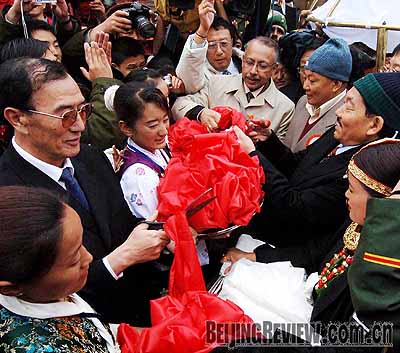|
|
 |
|
CROSS-BORDER MARKET: Chinese and Indian officials pay their respects to each other at a ceremony celebrating the reopening of the Nathu La market on the China-India border on July 6, 2006 |
Let me wish the readers of Beijing Review a happy and prosperous Year of the Ox, which incidentally starts this year on India's Republic Day. As celebrations, both traditional and modern, begin on both sides of the Himalayas, perhaps it would not be out of context here to cherish the millennial bonds of amity between our respective billions, and the energy, the promise and the potential that this vast agglomeration of humanity holds for our own future and that of the world.
During the visit of the then Indian Prime Minister Shri Rajiv Gandhi to China in December 1988, at which I was a delegate and witness to history in the making, our young leader's celebrated "long handshake" with China's leader, Deng Xiaoping, generated great excitement and anticipation as the two countries emerged out of their brief estrangement and looked boldly to the 21st century. We decided during the visit not to let differences on the boundary question-a complex issue which both of us are addressing in earnest, with important progress-hold back our relations in every other sphere from realizing their true potential. The visit remains a defining point in India-China relations, a historic opening that unveiled new vistas for all-round cooperation, one manifestation of which is bilateral trade volume booming by nearly 50 percent in 2008, despite the shrinking numbers in such transactions worldwide.
Today, there is an overarching consensus across India's political spectrum that an efficiently transacted, stable, durable and well-balanced relationship with China is vital to India. It is heartening to see similar sentiments expressed by the top leaders in China, who have defined ties with India as a strategic policy of their country. Our leaders today are meeting with increasing frequency, as befits the two great nations. Our two governments have decided to characterize our engagement in the changed geopolitical and geo-economic scenario as a Strategic and Cooperative Partnership for Peace and Prosperity. This means that we should not only take a strategic and long-term view of our bilateral ties in their multiple dimensions, but should constantly bear in mind our converging worldview of global, international and regional issues and events and thus give full play to our role as the two largest developing nations.
|

|
|
Indian Ambassador to China Nirupama Rao (COURTSEY TO INDIAN EMBASSY TO CHINA) | We are now engaged in a constructive dialogue on a number of issues, including political, economic, cultural, people-to-people and military cooperation. There is much more substantive interaction between the two governments, much deeper understanding of each other's positions on key issues, much stronger desire to learn from each other and much more acknowledgement of the common objectives and shared destiny of the two countries in their developmental processes. With growing economic and commercial ties, increased physical connectivity as well as the rapid and unprecedented flow of ideas, our two civil societies are today involved like never before in shaping their ties. Today, in the multilateral and international arena, whether it is the climate change debate or summits to decide the future of global finance and economy, we find ourselves adopting similar positions on issues of common concern to the developing world. China and India joining hands cannot only safeguard their own interests but also those of other developing nations. The development dynamic, through which each country holds out a model worthy of serious study by the other, puts the hotly debated India-China discourse in correct perspective. At a time when both our countries are busy eradicating poverty and ensuring better living standards for our citizens, our Strategic and Cooperative Partnership must reflect on the agenda of inclusive development as its biggest motivator.
The prerequisite for sustained development is peace and stability, internally as well as in our shared neighborhood and the world at large. We need to preserve regional and world peace and stability, prevent undesirable shocks, and work to make the existing world order more sustainable and equitable in light of contemporary reality. Our cooperation can range from maintaining peace and stability on our borders to effective cooperation within the UN, the WTO and the global community, to disarmament, non-proliferation and the elimination of weapons of mass destruction through to non-weaponization of outer space. We also need to strengthen our mutual consultation and cooperation to effectively counter the scourge of terrorism and cross-border terrorism, the most recent and gruesome demonstration of which was the series of attacks on the Indian financial capital of Mumbai on November 26 last year.
|
